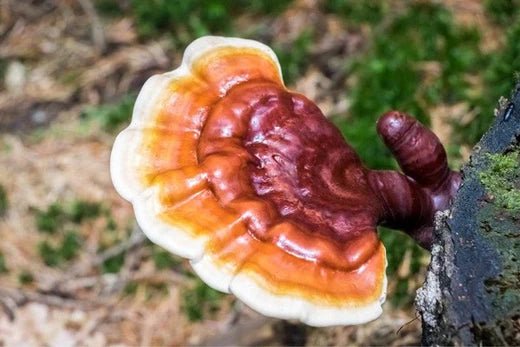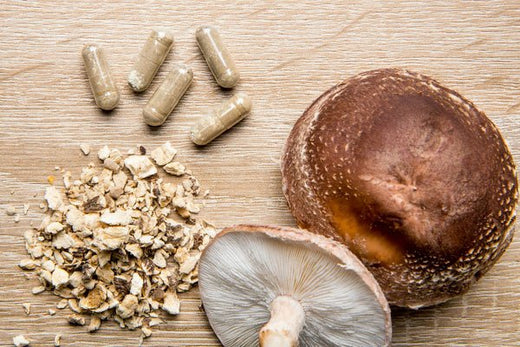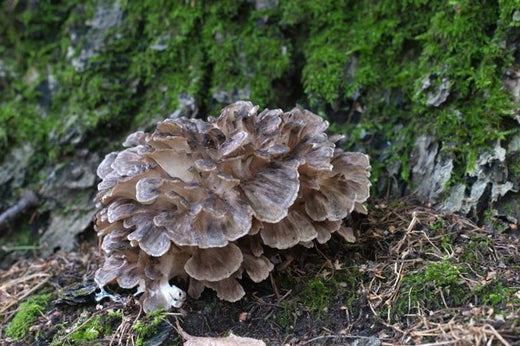Beta-Glucans: Secret Truth Behind The Healing Compounds in Medicinal Mushrooms
With a rich array of health-boosting compounds, functional mushrooms are your ultimate wellness allies.
These natural wonders are brimming with properties that boost your immune system, ease stress and anxiety, supercharge your energy, sharpen your memory and focus, improve digestion, balance hormones, and nurture your skin. All these benefits are backed by potent constituents like polysaccharides, triterpenoids, sterols, prebiotics, antioxidants, amino acids, and much more.
The star of the show? Beta-glucans! These exceptional polysaccharides have been the focus of extensive research, revealing their vital role in supporting our health. Found in fungi, yeast, and seaweed, they've become sought-after ingredients in a variety of wellness products.
As mushroom extracts gain popularity, there's no better time to explore the fantastic benefits of mushroom lattes and other functional mushroom products. But don't be fooled by marketing hype! While many companies claim high polysaccharide content, it's essential to know the difference between various types of polysaccharides and how they affect your health.
To make the best choices for your well-being, it's crucial to understand the testing and analysis process for mushroom β-glucans. Stay informed, and you'll be able to enjoy the full benefits of these powerful fungi while avoiding products that are low in quality or packed with unhealthy additives.
Embrace the world of medicinal mushrooms and experience the incredible health benefits that they offer. Your journey to wellness starts here!
Table of Contents
-
A Basic Understanding of Polysaccharides?
-
Beta-Glucans: The Best Type of Polysaccharide
-
Alpha-Glucans | A Filler In Mushroom Products
-
Mycelium on Grain (MOG) Cultivation
-
Mushroom Fruiting Body Extracts For Your Health
-
Grains Are Junk Food For Mushrooms
-
Appropriate Testing for Beta-Glucans
-
References and Studies

A Basic Understanding of Polysaccharides?
nature's versatile gems found in an array of sources like fungi, cereals, yeast, bacteria, and seaweed. These power-packed carbohydrates come in various forms, from the simplest monosaccharides like glucose, fructose, and galactose to complex, long-chain polysaccharides.
Polysaccharides are remarkable, with structures ranging from linear to highly branched, all formed by joining monosaccharides or disaccharides through glycosidic bonds. Some familiar examples include storage polysaccharides like starch and glycogen, as well as structural polysaccharides such as cellulose and chitin.
Cellulose, the most abundant polysaccharide on Earth, fortifies plant cell walls. Chitin, the second most abundant, is crucial in the cell walls of fungi and some bacteria, as well as the exoskeletons of insects, spiders, and crustaceans. While chitin is indigestible for humans, it's packed with the beneficial beta-glucans we crave.
To harness these healthful compounds, hot water extraction is key. This time-tested technique breaks down chitinous cell walls, unleashing the beta-glucans without compromising their structure. It's no wonder that for centuries, herbalists, practitioners, doctors, and researchers have cooked mushrooms, and most mushroom supplements are hot water or hot water/alcohol extracted. Remember to cook those store-bought mushrooms too – no more raw ones in your salads!
Mushrooms boast varying polysaccharide levels depending on their species and cultivation. For instance, Reishi, Maitake, and Turkey Tail mushrooms typically offer higher polysaccharide content (around 20-40%, depending on extraction methods). So, dive into the fascinating world of polysaccharides and unlock the incredible benefits they hold!

Beta-Glucans: The Best Type of Polysaccharide
Mushrooms, also known as basidiomycetes, are packed with a variety of polysaccharides, but the real stars are the beta-D-glucans.
These extraordinary compounds come in multiple forms, with the key one being the (1-3)(1-6) beta-D-glucans. This fascinating structure is exclusive to fungi and yeast, setting them apart from other sources like oats and grains that contain (1-4)-beta-glucans.

Alpha-Glucans | A Filler In Mushroom Products
Why are beta-glucans so special? It's all about their beta-linked glucose molecules, which create the characteristic fungal polysaccharide. When comparing different sources of polysaccharides, keep in mind that beta-glucans (and cellulose) are beta-linked, while others like starch are alpha-linked, or alpha-glucans (α-Glucans).
Don't let alpha-glucans (starch/glycogen) confuse you in the world of functional mushrooms. Embrace the unique qualities of mushrooms and their exceptional beta-D-glucans for a healthier and more vibrant lifestyle!

A depiction of Mushroom (Basidiomycete) Life Cycle
Mycelium on Grain (MOG) Cultivation
Mycelium, often compared to the root structure of fungi, is just one stage in a mushroom's life cycle. When cultivated using the MOG (mycelium on grain) method, the final product contains a high level of starch (alpha-glucans) and a low concentration of the bioactive beta-glucan compounds you're actually seeking.
In fact, a 2016 study evaluating medicinal mushroom products found that many contained mostly mycelium grown on grain, resulting in high amounts of alpha-glucans and minimal beta-glucans. For instance, Reishi, Cordyceps, and Chaga samples exhibited these undesirable proportions. It's crucial to understand that mushrooms naturally have minimal starch content, averaging less than 3% of their dry weight.

Mycelium growing on grain
Unfortunately, some companies exploit this situation by advertising high polysaccharide percentages without disclosing the true levels of beneficial beta-glucans. In some cases, they may claim over 60% polysaccharides, even though their products are primarily composed of nutritionally insignificant alpha-glucans.
What's more, the FDA does not recognize mycelium as a mushroom, yet many companies continue to market their mycelium-based products as such, masking the truth by only revealing their total polysaccharide numbers.
Don't be misled! Seek out authentic mushroom products that prioritize health-boosting beta-glucans over starch content to experience the full benefits of these incredible fungi.
To ensure you're getting the most value from your mushroom supplements, pay attention to the following factors:
- Transparency: Choose companies that openly share information about their product's beta-glucan and alpha-glucan content. This will help you avoid products with high starch levels and low nutritional value.
- Fruiting Bodies: Opt for products that utilize the actual mushroom fruiting bodies instead of mycelium, as these are more likely to provide the beneficial beta-glucans you're seeking.
- Traditional Growing Methods: Prioritize supplements sourced from mushrooms cultivated on natural wood substrates. This traditional approach enhances the nutritional profile of the final product.
- Third-Party Testing: Select products that have undergone independent lab testing for quality assurance. This helps to confirm the presence of beneficial compounds and ensures the product is free from contaminants.

Log-grown Reishi mushroom (Ganoderma lucidum) fruiting body
Mushroom Fruiting Body Extracts For Your Health
choose fruiting body extracts over mycelium extracts for a powerful and nutrient-rich supplement that truly delivers on its promises.
Why settle for a less effective option when the fruiting body extracts outshine mycelium extracts in potency, quality, and health benefits? Rich in bioactive beta-glucans and a wide array of nutritional components, fruiting body extracts are the superior choice for those seeking the best possible health results.
Did you know that mycelium on grain products are a cost-cutting measure used by manufacturers to produce supplements quickly and inexpensively? However, these products fall short in terms of benefits and potency. Don't let your hard-earned money go to waste on a "mushroom" supplement that doesn't deliver.
If you're embracing a grain-free or paleo diet, you might be surprised to learn that consuming mycelium on grain products could be sabotaging your efforts. Make an informed choice and avoid these extra grains.

Grains Are Junk Food For Mushrooms
Just like us, mushrooms need a balanced and nutrient-rich diet to thrive. Feeding mushroom mycelium a grain-based diet hinders their growth and limits their nutrient profile. It's like raising a child on junk food – you wouldn't do it, so why settle for a mushroom supplement with subpar nourishment?
A grass-fed steak is widely considered healthier than one from a grain-fed cow. The same principle applies to mushrooms: those grown on wood substrates closely mimic their natural environment, providing optimal nourishment and leading to a healthier, more potent mushroom.
Wood substrates, the ideal food source for mushrooms, are equivalent to a well-rounded human diet. They encourage a thriving, competitive environment where mushrooms develop adaptogenic qualities and potentially engage in synergistic relationships with other organisms. This natural approach to cultivation leads to a superior product compared to grain alternatives.
To optimize your health, choose mushroom-fruiting body extracts grown on wood substrates and processed through hot water or dual extraction (hot water/alcohol). This ensures a final product rich in beta-D-glucans, giving you the powerful health benefits you deserve.
Appropriate Testing for Beta-Glucans
The regulatory community has expressed concerns about the identity and purity of mushroom products on the market, but we're here to put your mind at ease.
Many conventional beta-glucan testing methods were designed for grains and are not suitable for accurately measuring the unique (1-3)(1-6) beta-D-glucans found in mushrooms. But don't worry – a game-changing solution is here!
Introducing the groundbreaking testing method developed by Dr. Barry McCleary of Megazyme International in Ireland, designed specifically for mushrooms. This cutting-edge method has become the gold standard for beta-glucan testing and is trusted by the USDA and scientific researchers worldwide to precisely measure beta-D-glucans in mushrooms.
Want to check for alpha-glucans in your mushroom products yourself? It's as easy as performing a simple at-home starch test with iodine!
At Teelixir, we proudly use the Megazyme method to test all our mushroom extracts, ensuring you get the highest quality and potency possible. Check out the impressive results for each of our products on their respective pages. Trust Teelixir for the purity and potency you deserve in your mushroom products.
References and Studies:
Novak M, Vetvicka V (2008). Beta-glucans, history, and the present: immunomodulatory aspects and mechanisms of action. J Immunotoxicol. 2008 Jan;5(1):47-57. doi: 10.1080/15476910802019045.
Asma Ashraf Khan, Adil Gani, Firdous A.Khanday, F.A. Masoodi (2018). Biological and pharmaceutical activities of mushroom β-glucan discussed as a potential functional food ingredient. Bioactive Carbohydrates and Dietary Fibre Volume 16, October 2018, Pages 1-13 https://doi.org/10.1016/j.bcdf.2017.12.002
http://www.edinformatics.com/math_science/what_are_polysaccharides.htm
Mark Stengler, N.D. (2005). The Health Benefits of Medicinal Mushrooms. Basic Health Publications, Inc.
Sari, M., Prange, A., Lelley, J. I., & Hambitzer, R. (2017). Screening of beta-glucan contents in commercially cultivated and wild growing mushrooms. Food Chemistry, 216, 45–51.
Chilton, J. Nammex: Redefining Medicinal Mushrooms, 2015 - http://www.nammex.com/redefining-medicinal-mushrooms/
McCleary, B. V., & Draga, A. (2016). Measurement of Beta-Glucan in mushrooms and mycelial products. Journal of AOAC International, 99(2), 364–373. http://doi.org/10.5740/jaoacint.15-0289
Disclaimer
The materials and information provided in this article from Teelixir Pty Ltd. are strictly for informational purposes only and are not intended for use as diagnosis, prevention or treatment of a health problem or as a substitute for consulting a qualified medical professional. Please consult your medical practitioner for advice about all food products related to this website before including them into your health program, or making any changes to your diet, lifestyle, or exercise program. Teelixir will not be responsible for any use, non-use, or misuse of any product that is sold or distributed via this website.








